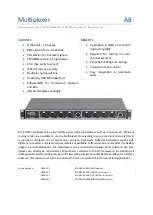
9
1.
The 8455 should only be used by personnel who are qualified to recognize
shock hazards and are trained in the safety precautions required to avoid
possible injury.
2.
Do not connect any terminal of this Instrument to a circuit point at which a
voltage exceeding 100 volts DC may exist with respect to earth ground.
(Refer to Table 8-1, item 4).
3.
This Instrument is intended only for indoor use or in sheltered outdoor loca-
tions. To prevent fire or shock hazards, do not expose Instrument to rain or
moisture.
4.
Before using this Instrument, check both the Instrument and the test leads for
missing, damaged, deteriorated or faulty insulation. Do not use the instru-
ment until it has been properly repaired.
5.
DC voltages under 60V are not considered to be a shock hazard; however,
the meter is capable of measurements up to 100V. If the Instrument is to be
used to measure voltages exceeding 60V DC, precautions should be taken
to avoid bodily contact with the energized circuit.
6.
Do not make electrical measurements where the air may contain explosive
concentrations of gas or dust such as in mines, grain elevators, gasoline
stations or in the presence of charging batteries, until determined to be safe
by qualified personnel. Note that even metallic dust can be explosive.
7.
Do not use this Instrument to make electrical measurements on blasting
circuits or blasting caps.
10.
OPERATION
10.1
Mechanical Zero Adjustment
For accuracy of all measurements, the meter pointer must rest directly over the 0
POINTS mark at the left end of the dial scale when the ON/OFF switch is set to the
OFF position. If the pointer is not in that position, rotate the mechanical zero adjust
screw (Figure 8-1, item 7) in either direction until it does.
10.2
Battery Adjustment (Resistance Ranges)
For accuracy of resistance measurements, the meter pointer must rest directly
over the 100 POINTS mark at the right end of the dial scale when the ON/OFF
switch is set to the ON position and the test clips are shorted together. If the pointer
is not in that position, adjust the BATTERY ADJUSTMENT control (Figure 8-1,
item 5).
10.3
Storage and/or Transport
Keep the ON/OFF switch in the OFF position at all times except when making
measurements. This will prevent battery discharge in the event that the test clips
are accidentally shorted together during storage or transport.
NOTE:
Before making a resistance or ballistics test, connect the Instrument to the
line with the ON/OFF switch in the OFF position (voltage measurement) to detect
the presence of unexpected DC voltages. The presence of DC voltages will cause
inaccurate test readings and may damage the meter.
www.
.com
1.800.561.8187

































